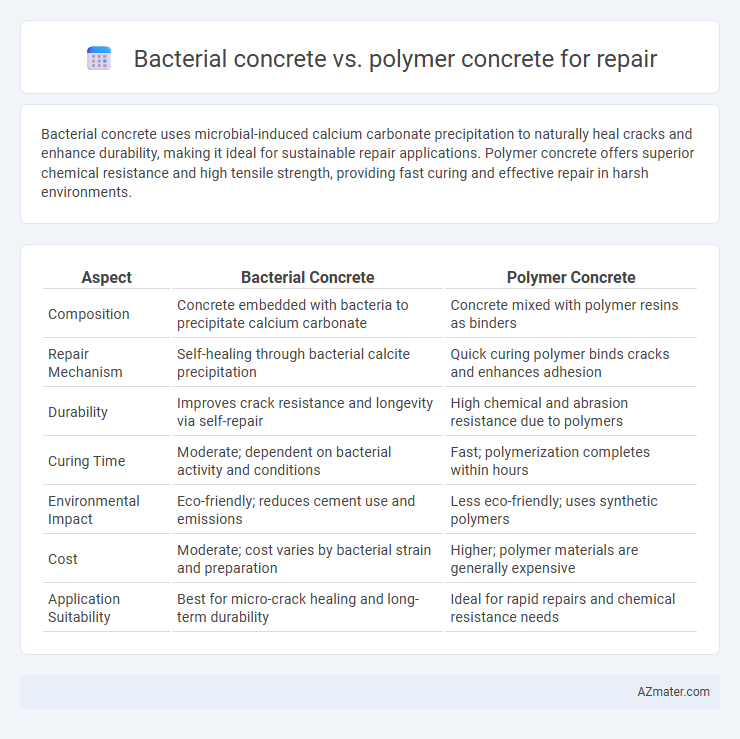Bacterial concrete uses microbial-induced calcium carbonate precipitation to naturally heal cracks and enhance durability, making it ideal for sustainable repair applications. Polymer concrete offers superior chemical resistance and high tensile strength, providing fast curing and effective repair in harsh environments.
Table of Comparison
| Aspect | Bacterial Concrete | Polymer Concrete |
|---|---|---|
| Composition | Concrete embedded with bacteria to precipitate calcium carbonate | Concrete mixed with polymer resins as binders |
| Repair Mechanism | Self-healing through bacterial calcite precipitation | Quick curing polymer binds cracks and enhances adhesion |
| Durability | Improves crack resistance and longevity via self-repair | High chemical and abrasion resistance due to polymers |
| Curing Time | Moderate; dependent on bacterial activity and conditions | Fast; polymerization completes within hours |
| Environmental Impact | Eco-friendly; reduces cement use and emissions | Less eco-friendly; uses synthetic polymers |
| Cost | Moderate; cost varies by bacterial strain and preparation | Higher; polymer materials are generally expensive |
| Application Suitability | Best for micro-crack healing and long-term durability | Ideal for rapid repairs and chemical resistance needs |
Introduction to Concrete Repair Technologies
Bacterial concrete employs microbial-induced calcite precipitation to heal cracks autonomously, enhancing durability and reducing maintenance costs in infrastructure repair. Polymer concrete utilizes synthetic resins as binders, offering superior adhesion, chemical resistance, and rapid curing times, making it ideal for structural rehabilitation and surface restoration. Both technologies represent advanced solutions in concrete repair, with bacterial concrete focusing on self-healing properties and polymer concrete emphasizing mechanical strength and environmental resistance.
Overview of Bacterial Concrete
Bacterial concrete utilizes specific strains of bacteria, such as Bacillus pasteurii, to induce calcium carbonate precipitation, effectively healing cracks and enhancing durability in concrete structures. This bio-based approach promotes self-repair by filling micro-cracks autonomously, reducing maintenance costs and extending service life. Its eco-friendly nature and ability to improve mechanical properties position bacterial concrete as a sustainable alternative to traditional repair methods.
Overview of Polymer Concrete
Polymer concrete is a composite material composed of polymer resin binders combined with aggregates, offering superior chemical resistance and mechanical strength compared to traditional cement-based materials. Widely used in repair applications, it provides excellent adhesion to existing concrete structures, rapid curing times, and enhanced durability in harsh environmental conditions. Its ability to resist corrosion, abrasion, and shrinkage makes polymer concrete a preferred choice for structural rehabilitation and infrastructure maintenance.
Mechanism of Self-Healing in Bacterial Concrete
Bacterial concrete employs microbial-induced calcite precipitation (MICP) where bacteria like Bacillus pasteurii produce calcium carbonate, sealing cracks and enhancing durability. Polymer concrete utilizes synthetic resins to fill cracks and bond aggregates, offering immediate mechanical strength but lacks a biological self-repair process. The self-healing mechanism in bacterial concrete is sustainable and autonomous, enabling repeated crack closure through ongoing microbial activity without external intervention.
Properties and Composition of Polymer Concrete
Polymer concrete is composed of a polymer binder such as epoxy, polyester, or vinyl ester combined with aggregates like sand, gravel, or quartz, offering superior chemical resistance, rapid curing, and high mechanical strength compared to traditional cementitious materials. Bacterial concrete relies on microbial activity to precipitate calcium carbonate, enhancing crack healing and self-repairing properties but typically lacks the immediate structural strength and chemical durability of polymer concrete. The intrinsic properties of polymer concrete, including low permeability, high tensile and compressive strength, and excellent adhesion to substrates, make it highly suitable for demanding repair applications where long-term durability and resistance to aggressive environments are critical.
Durability and Longevity Comparison
Bacterial concrete enhances durability by inducing calcium carbonate precipitation, effectively sealing micro-cracks and reducing permeability, which prolongs structural lifespan. Polymer concrete offers excellent chemical resistance and mechanical strength, ensuring superior durability in aggressive environments and heavy load applications. Comparing longevity, bacterial concrete promotes self-healing, reducing maintenance frequency, while polymer concrete provides consistent performance with minimal degradation under harsh conditions.
Environmental Impact and Sustainability
Bacterial concrete utilizes microbial-induced calcite precipitation to heal cracks autonomously, significantly reducing the need for conventional repair materials and lowering carbon emissions. Polymer concrete incorporates synthetic polymers as binders, which enhances durability but relies on petrochemical-based components with higher environmental footprints. Sustainable construction favors bacterial concrete due to its bio-based processes, self-healing properties, and decreased lifecycle energy consumption compared to polymer concrete's less biodegradable, resource-intensive composition.
Cost Analysis and Economic Feasibility
Bacterial concrete offers a sustainable and self-healing solution with potentially lower long-term maintenance costs due to its crack-sealing capability, but initial production and application expenses remain relatively high. Polymer concrete provides rapid curing and superior chemical resistance, often resulting in higher upfront material costs, yet reduces labor costs through faster setting times and enhanced durability. Economic feasibility depends on project scale and lifespan, with bacterial concrete favored for sustainability-driven projects and polymer concrete chosen for quick repairs requiring strong chemical resistance.
Application Areas and Limitations
Bacterial concrete is primarily used in repairing cracks and micro-damages in concrete structures through bio-mineralization, making it ideal for self-healing applications in civil infrastructure such as bridges and tunnels. Polymer concrete excels in chemical resistance and adhesion, making it suitable for industrial flooring, sewage systems, and areas exposed to aggressive chemicals but has limitations regarding UV degradation and high cost. Both materials face challenges in large-scale applications due to durability concerns under extreme environmental conditions and compatibility with existing concrete.
Conclusion and Future Trends
Bacterial concrete exhibits superior self-healing properties and environmental benefits compared to polymer concrete, which offers enhanced mechanical strength and chemical resistance for repair applications. Future trends point toward hybrid composites integrating microbial activity with advanced polymers to optimize durability and sustainability in structural repairs. Research continues on bio-compatible additives and nano-engineered polymers to extend the lifespan and reduce maintenance costs in infrastructure rehabilitation.

Infographic: Bacterial concrete vs Polymer concrete for Repair
 azmater.com
azmater.com